The sundew is round-leaved or dewdrop looks unusual and has healing properties. Due to climate change and drainage of swamps, it becomes difficult to find it in nature. About how to grow a plant on your windowsill, look after it, and use it for treatment, read the article.
Material Content:
Plant description
This small plant is spread on the ground. Only a long peduncle rises above the leaves, dangerous for insects, to get the desired pollination. Small white flowers collected in long curls bloom from June to August.
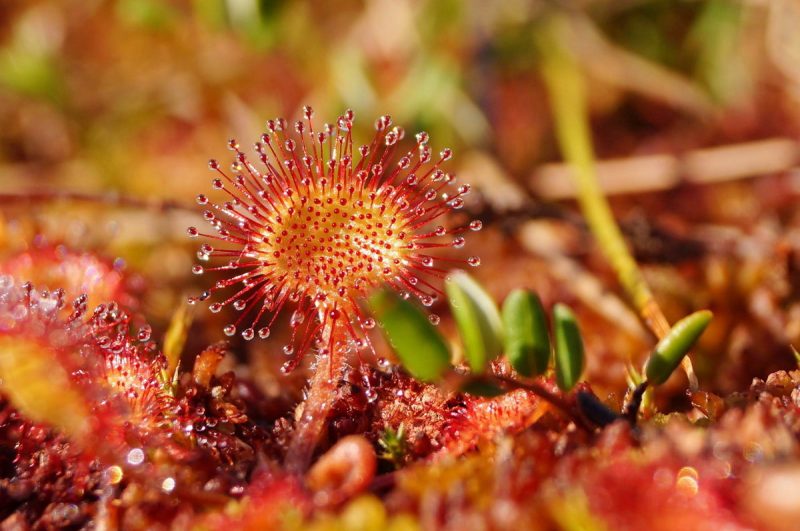
Oval light green leaves with a diameter of about 2 cm, with red hairs, look very decorative. They shine in the sun, covered like diamonds with droplets of a clear liquid.
What group does the plant belong to?
Sundew or sun dew refers to carnivorous flora that grows on all types of soil. The plant feeds on insects.

This perennial grass belongs to the family Rosyankovye. These are dicotyledonous plants, included in the order of cloves. In addition to Rosyanka, this family includes two more species - Aldrovand and Venus flytrap.
Where grows
Dewdrops most often grow in wetlands, where you can find a sundew. She prefers sphagnum bogs in the Northern Hemisphere, but can also grow on wet sands or peat soils throughout the European part, except for the southern regions.

Where the sundew grows, there may not be an underground water supply, the plant has enough moisture from precipitation, and snacks by insects.
It develops very slowly, differs in small sizes. Life expectancy up to 40 years.
How is insect fishing
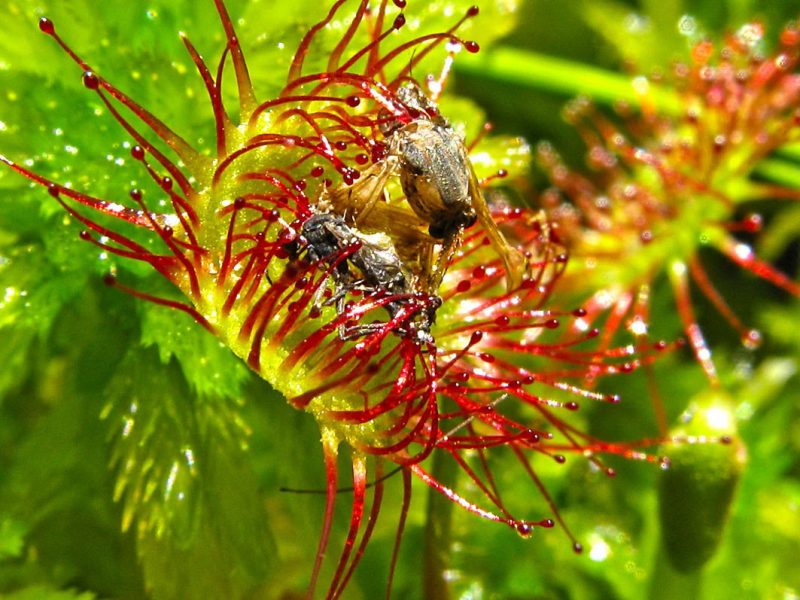
A sticky substance is produced in the leaves, which contains the alkaline coniin. It has a paralyzing effect for insects, and contains digestive enzymes. When the next victim sticks to the sticky juice, the leaf plate closes.
Interesting facts about sun dew
Rosichka is used in folk medicine. Its fresh leaves help quickly remove warts from the skin.
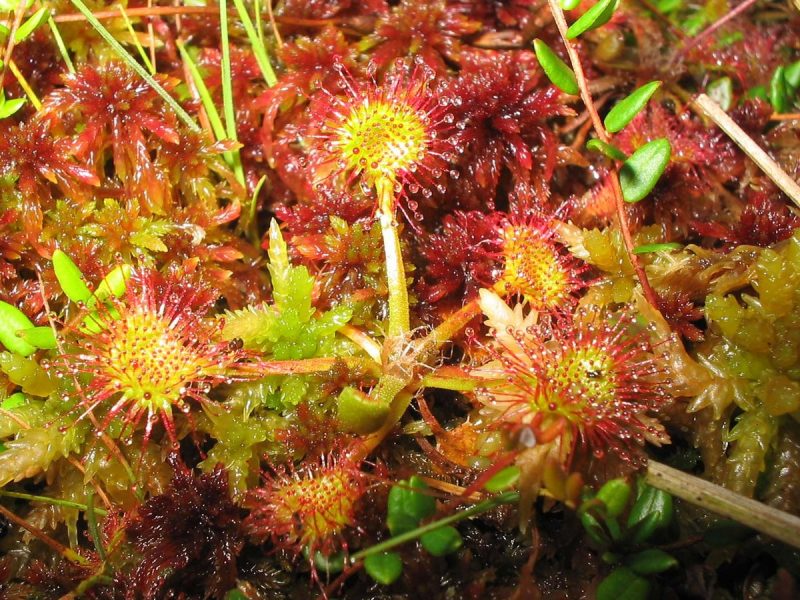
From the dry part of the grass, tinctures are prepared on water and alcohol, which treat:
- cough;
- whooping cough;
- bacterial infections;
- painful cramps of smooth muscles of internal organs;
- swelling
- fever
- bronchial asthma;
- laryngitis;
- candidiasis;
- headache;
- epilepsy.
For the preparation of water tincture 1 tsp crushed dry leaves, pour 250 ml of boiling water. Insist to cool. Having stretched, take 3 or 4 times a day for 1 tbsp. l after eating.
To prepare alcohol tincture, 20 g of dried grass pour 200 ml of 40% alcohol, and insist 10 days at room temperature in a dark place. Take 15 drops, dissolving in 50 ml of water, 3 or 4 times a day.
Most often, tincture of sundew is used for respiratory diseases. Fresh young leaves are used to remove warts. They are applied with a sticky side to the wart, and it soon disappears, thanks to the substances that the plant contains.
The aboveground part of the sundew is harvested all summer and autumn. Dry by a quick method in special dryers at a temperature of 40 ° C.

In Italy, round-necked sundew is used to make Rosolio liqueur. This drink was popular at the royal court during the Savoy dynasty, and at the end of the XVIII century it spread throughout Italy.
Earlier we used sundew to treat sick pets and to sterilize milk pots. They placed a plant in an empty milk vault, poured water, and set it to steam in an oven. The substances contained in the grass dissolved proteins even in the walls of ceramic vessels.
Whether the sundew is included in the Red Book
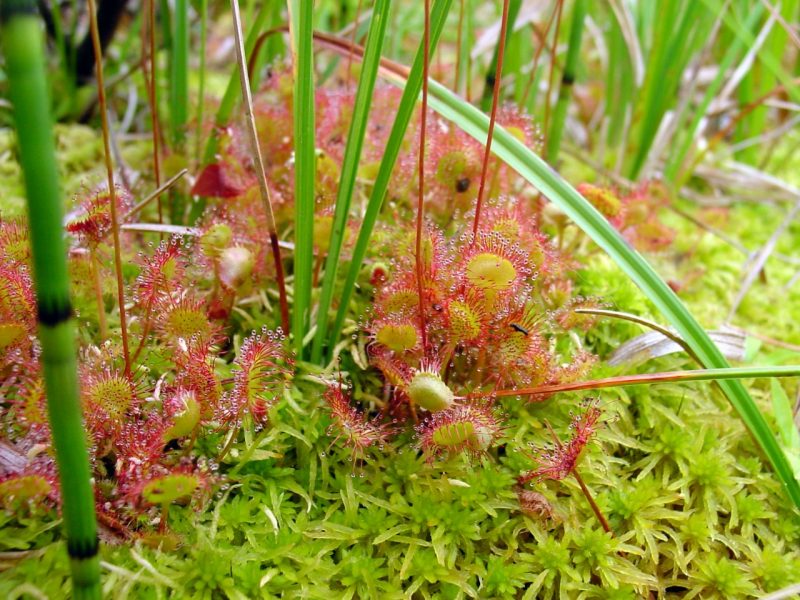
The sundew is not included in the Russian Red Book. From the family Rosyankovye, as an endangered species, only Aldrovand is bubbly. It does not withstand competition with other insectivorous plants, and disappears due to drainage of swamps, pollution of water bodies and climatic changes.
You can find the sundew in the Red Book of the Orenburg Region, in this region the plant is in danger of extinction.
How to grow a sundew in a room
Round-leaved sundew is the most unpretentious insectivorous plant. But, growing it, you can forget all the traditional rules for caring for indoor flowers.

It is best to plant a sundew in a substrate consisting of sphagnum moss, acid peat and perlite soaked in distilled water. Such a soil is moisture-intensive, and at the same time very light.
It is desirable to water a sundew from the pallet. For irrigation use only distilled water, it is important to do so that the plants do not get sick.
You can’t fertilize, the leaves will cease to produce a sticky substance, and will not be able to feed. For growth, sundews need only bright diffused light. Propagated by daughter rosettes or tiny seeds.
Only fresh seeds are suitable for sowing, over time they lose germination. Freshly picked, they can be stored in the refrigerator at +10 ° C for about 6 months.
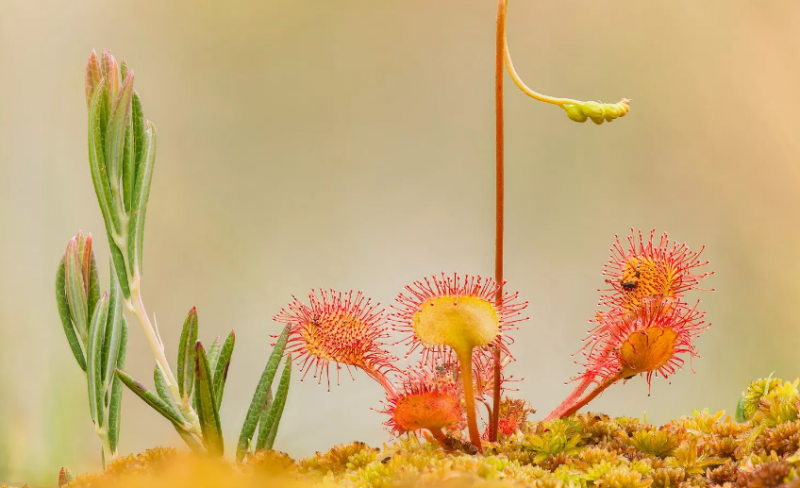
The soil for sowing seeds is prepared from 2 parts of peat and 1 part perlite (previously it is soaked for 1 week in distilled water). Aged seeds in the refrigerator are sown on the surface of the soil with a toothpick. To seedlings are better rooted, the surface of the substrate is sprinkled with crushed sphagnum layer of 5 mm.
It is important that the peat used is not deoxidized, with a pH of 2–3.5, otherwise the seeds will not sprout.
A seeded sundew is sprayed from a spray bottle with a Topaz solution. Then make a greenhouse, covering the seeds with a bag.Put under the lamps for 14-16 hours of daylight at a temperature of from 20 to 27 ° C. The first shoots should appear in a month.
The greenhouse is being cleaned gradually, accustoming seedlings to the drier air of the apartment. Transplant seedlings need not earlier than six months after germination.
In winter, the aerial part of the plant can die off, retaining the buds of renewal, which in the spring will give new shoots. It is advisable to reduce watering to a minimum.
Growing a predatory plant with a sundew is a fascinating activity. It will live a long time, and delight with its unusual appearance, if properly looked after.












